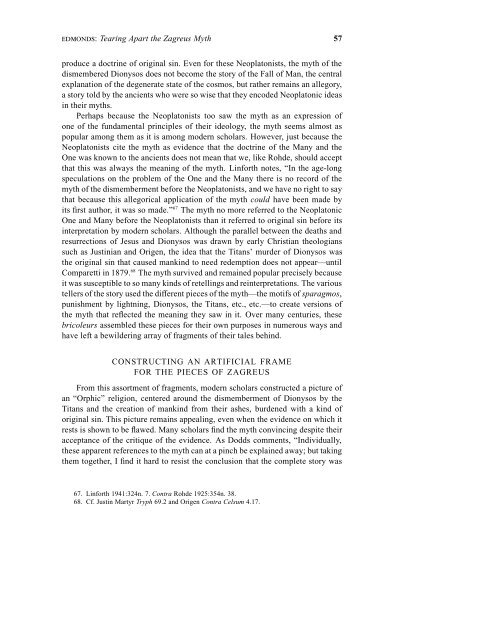Tearing Apart the Zagreus Myth - Bryn Mawr College
Tearing Apart the Zagreus Myth - Bryn Mawr College
Tearing Apart the Zagreus Myth - Bryn Mawr College
Create successful ePaper yourself
Turn your PDF publications into a flip-book with our unique Google optimized e-Paper software.
EDMONDS: <strong>Tearing</strong> <strong>Apart</strong> <strong>the</strong> <strong>Zagreus</strong> <strong>Myth</strong> 57<br />
produce a doctrine of original sin. Even for <strong>the</strong>se Neoplatonists, <strong>the</strong> myth of <strong>the</strong><br />
dismembered Dionysos does not become <strong>the</strong> story of <strong>the</strong> Fall of Man, <strong>the</strong> central<br />
explanation of <strong>the</strong> degenerate state of <strong>the</strong> cosmos, but ra<strong>the</strong>r remains an allegory,<br />
a story told by <strong>the</strong> ancients who were so wise that <strong>the</strong>y encoded Neoplatonic ideas<br />
in <strong>the</strong>ir myths.<br />
Perhaps because <strong>the</strong> Neoplatonists too saw <strong>the</strong> myth as an expression of<br />
one of <strong>the</strong> fundamental principles of <strong>the</strong>ir ideology, <strong>the</strong> myth seems almost as<br />
popular among <strong>the</strong>m as it is among modern scholars. However, just because <strong>the</strong><br />
Neoplatonists cite <strong>the</strong> myth as evidence that <strong>the</strong> doctrine of <strong>the</strong> Many and <strong>the</strong><br />
One was known to <strong>the</strong> ancients does not mean that we, like Rohde, should accept<br />
that this was always <strong>the</strong> meaning of <strong>the</strong> myth. Linforth notes, “In <strong>the</strong> age-long<br />
speculations on <strong>the</strong> problem of <strong>the</strong> One and <strong>the</strong> Many <strong>the</strong>re is no record of <strong>the</strong><br />
myth of <strong>the</strong> dismemberment before <strong>the</strong> Neoplatonists, and we have no right to say<br />
that because this allegorical application of <strong>the</strong> myth could have been made by<br />
its first author, it was so made.” 67 The myth no more referred to <strong>the</strong> Neoplatonic<br />
One and Many before <strong>the</strong> Neoplatonists than it referred to original sin before its<br />
interpretation by modern scholars. Although <strong>the</strong> parallel between <strong>the</strong> deaths and<br />
resurrections of Jesus and Dionysos was drawn by early Christian <strong>the</strong>ologians<br />
such as Justinian and Origen, <strong>the</strong> idea that <strong>the</strong> Titans’ murder of Dionysos was<br />
<strong>the</strong> original sin that caused mankind to need redemption does not appear—until<br />
Comparetti in 1879. 68 The myth survived and remained popular precisely because<br />
it was susceptible to so many kinds of retellings and reinterpretations. The various<br />
tellers of <strong>the</strong> story used <strong>the</strong> different pieces of <strong>the</strong> myth—<strong>the</strong> motifs of sparagmos,<br />
punishment by lightning, Dionysos, <strong>the</strong> Titans, etc., etc.—to create versions of<br />
<strong>the</strong> myth that reflected <strong>the</strong> meaning <strong>the</strong>y saw in it. Over many centuries, <strong>the</strong>se<br />
bricoleurs assembled <strong>the</strong>se pieces for <strong>the</strong>ir own purposes in numerous ways and<br />
have left a bewildering array of fragments of <strong>the</strong>ir tales behind.<br />
CONSTRUCTING AN ARTIFICIAL FRAME<br />
FOR THE PIECES OF ZAGREUS<br />
From this assortment of fragments, modern scholars constructed a picture of<br />
an “Orphic” religion, centered around <strong>the</strong> dismemberment of Dionysos by <strong>the</strong><br />
Titans and <strong>the</strong> creation of mankind from <strong>the</strong>ir ashes, burdened with a kind of<br />
original sin. This picture remains appealing, even when <strong>the</strong> evidence on which it<br />
rests is shown to be flawed. Many scholars find <strong>the</strong> myth convincing despite <strong>the</strong>ir<br />
acceptance of <strong>the</strong> critique of <strong>the</strong> evidence. As Dodds comments, “Individually,<br />
<strong>the</strong>se apparent references to <strong>the</strong> myth can at a pinch be explained away; but taking<br />
<strong>the</strong>m toge<strong>the</strong>r, I find it hard to resist <strong>the</strong> conclusion that <strong>the</strong> complete story was<br />
67. Linforth 1941:324n. 7. Contra Rohde 1925:354n. 38.<br />
68. Cf. Justin Martyr Tryph 69.2 and Origen Contra Celsum 4.17.
















